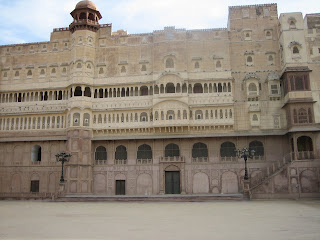HareKrsna
The city Bikaner is about 330 km from Jaipur, and it is well connected by road.
The city has direct rail connections to all metro cities....
Railway station of Bikaner.....
Bikaner founded in 1488 AD by Rao Bika Ji, it's located in north west part of Rajasthan. The imposing palaces, beautiful and richly sculptured temples of red and yellow sand stones display some of the finest creations of Rajput civilization.
The hot attractions of Bikaner are -
The JunaGarh Fort - This fort was built by Raja Rai Singhji, the sixth ruler of Bikaner, who ruled form 1571 to 1612 AD.
There are 37 bastions guarding the fort with only two gate- Suraj Pol and Karan Pol. The Junagarh Fort has defied all the attacks except for the brief stint by Kamaran who captured the fort but was unable to retain his victory more than 24 hours.
The main gate is mostly kept facing east, because the sun rises in the east, it is called Suraj Pol.
View from outside of Karan Pol......
Karan Pol which is the main entrance today. When you enter into Karan Pol you can see some symbolic hands sculpted on a vertically fixed stone slab on the left side. These are Sati hands, reminders of the royal Royal ladies who committed sati.
The Fort include palaces with intricately delicate balconies, towers and kiosks, temples and pavilions, carved windows also known as Jharokas. See here, beauty of the windows inside the Fort.......
Temples and pavilions that are marvels in red sandstone construction. Har Mandir is the main temple in Fort.
View of Har Mandir...
In Har Mandir, a majestic chapel, the royal family worshipped their gods and goddess. Timings : 10.00 hrs. to 16.30 hrs.
Some places of interest inside the fort are Anup Mahal, Chandra Mahal, Phool Mahal and Rang Mahal.
The mirrors, paintings and carved marble panels in the Moon palace are a treat for eyes. You can see here the interior inside Moon/Chandra Palace....
Chandra Mahal - is the most luxurious room in the palace, which houses gold plated deities and paintings inlaid with precious stones. In the royal bedroom, mirrors have been strategically placed so that the king could see from his bed, any intruder entering his room.
The Phool Mahal or Flower palace was adorned with glasses and mirrors. This is oldest part of the palaces and was built by Raja RAi Singhji. Inside the rooms the interior walls are decorated with stucco work and glass inlay work.
A view of courtyard in Phool Mahal......
Karan Mahal (Public Audience Hall), the first monument of Bikaner. The beautiful palace was built by Karan Singh, the ninth ruler of Bikaner State, who ruled the State, during 1631-1685 A.D. The Karan Palace is one of the most interesting palaces of Junagarh Fort. This particular palace was special court where the king used to hold meetings with his distinguished knights.
Jharoka at Karan Mahal.......
Karan Mahal is covered with rich Rajput elaboration of Mughal style in terms of the purity of white marble and stucco design.
This is the state Flag of Bikaner is placed in Karan Mahal. It has two colours - Kesaria and Kasumal (Saffron & Red). Upper colour Kasumal is symbolic of Karni Mata the presiding deity of Bikaner Royal family and the lower colour Kesaria symbolizes Laxmi Nathji the tutelary deity of the Bikaner Royal family.
Anup Mahal - is a multistory structure, which functioned as the administrative headquarters of the kingdom. It has ornate wooden ceilings with inlaid mirrors, Italian tiles, and fine windows and balconies. It has some gold leaf paintings. It is considered as one of the “grandest construction”.
Here you can see the Royal Bedroom of King in Chandra Mahal
Badal Mahal (The weather palace) is part of the Anup Mahal extensions. It has paintings of Shekawati style.
Ganga Mahal - was built in the 20th century by Ganga Singh, it has large Durbar Hall.
This plane was presented to the King......
These called The Chattries......
This is Elephant, Camels Stables....
Courtyards......
HareKrsna
































































